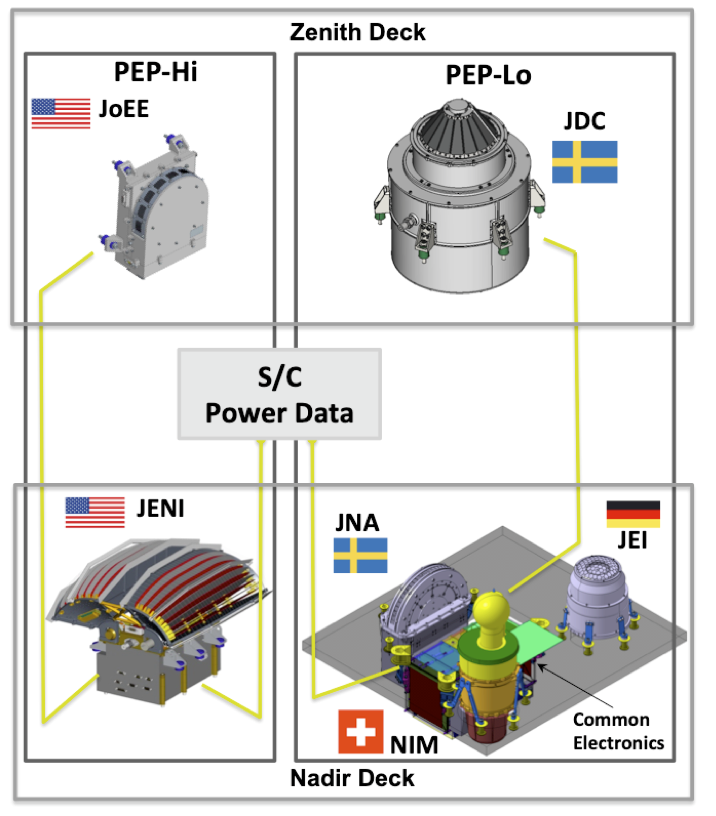The Particle Environment Package (PEP) for the JUICE mission: Ready to go!
- 1Swedish Institute of Space Physics, Kiruna, Sweden (stas@irf.se)
- *A full list of authors appears at the end of the abstract
1. PEP objectives
The PEP suite explores the particle populations in the Jovian system to answer three overarching science questions:
(1) How does the corotating magnetosphere of Jupiter interact with Ganymede, Callisto, Europa, and Io?
(2) How do internal and solar wind drivers cause such energetic, time variable and multi-scale phenomena in the steadily rotating giant magnetosphere of Jupiter?
(3) What are the structure and composition of the icy moons exospheres and how do they response to the external conditions?
2. PEP suite
PEP measures positive and negative ions, electrons, exospheric neutral gas, thermal plasma and energetic neutral atoms present in all domains of the Jupiter system over nine decades of energy from < 0.001 eV to > 1 MeV with full angular coverage. The six PEP sensors are:
- Jovian plasma Dynamics and Composition analyzer (JDC);
- Jovian Electrons and Ions analyzer (JEI);
- Jovian Energetic Electrons (JoEE);
- Jovian Energetic Neutrals and Ions sensors (JENI);
- Jovian Neutrals Analyzer (JNA);
- Neutral gas and Ion Mass spectrometer (NIM).
For the first time at Jupiter PEP combines global imaging via remote sensing using ENAs with in-situ measurements and performs global imaging of Europa/Io tori and magnetosphere combined with energetic ion measurements. Using low energy ENAs originating from the particle – surface interaction PEP investigate space weathering of the icy moons by precipitation particles. PEP will first-ever directly sample the exospheres of Europa, Ganymede, and Callisto with high mass resolution.

Figure 1: PEP suite and PEP sensors
3. PEP ready to go
All flight models of the PEP sensors and electronics as well as central processing unit and common power supply system have been tested, qualified, and calibrated. The complete model was delivered to ESA and ready for launch in April 2023. All sensors performance fulfilles the mission requirements. PEP will provide the most comprehensive simultaneous measurements of the plasma and neutral gas environment in the Jovian system and at the Galilean moon.
Swedish Institute of Space Physics, Box 812, SE-98128, Kiruna, Sweden (IRF): M. Wieser (JDC Lead), M.Shimoyama (JNA Lead), M. Holmström, Y. Futaana, G. Stenberg, H. Nilsson¦ ¦ Swedish Institute of Space Physics, Box 537, SE-751 21, Uppsala, Sweden (IRFU): A. Eriksson (Science with RPWI)¦ ¦ University of Bern, Physikalisches Institut, CH-3012 Bern, Switzerland (UBe): P. Wurz (SL: NIM), M. Tulej, A. Vorburger, A. Galli, N. Thomas¦ ¦ Applied Physics Laboratory, Johns Hopkins Univ., Laurel, MD, 20723-6099, USA (JHU/APL): G. Clark, (SL: JoEE), D. G. Mitchell (SL: JENI), M. Gkioulidou, G. Ho, B. H. Mauk, D. Haggerty, J. H. Westlake¦ ¦ Southwest Research Institute, San Antonio, TX 78228, USA: F. Allegrini¦ ¦ Los Alamos National Laboratory, Los Alamos, NM 87545, USA: H. Funsten¦ ¦ Institute of Geophysics and Planetary Physics, UCLA, Los Angeles, CA, 90095, USA (UCLA): Krishan Khurana (Science) ¦ ¦ Dept. of Atmospheric, Oceanic and Space Sciences, University of Michigan, Ann Arbor, MI 48109-2143, USA (U-M): Xianzhe Jia (Science)¦ ¦ University of Oregon, Clark Honors College & Earth Sciences, Eugene, USA: C. Paty (Science)¦ ¦ Max Planck Institute for Solar System Research, Göttingen, Germany (MPS): M. Fränz (SL: JEI), N. Krupp, E. Roussos¦ ¦ Institut für Experimentelle und Angewandte Physik, Christian-Albrechts-Universität Kiel, Leibnizstraße 11, 24118 Kiel, Germany (CAU): R. F. Wimmer-Schweingruber B. Heber¦ ¦ Institute of Space and Astronautical Science 3-1-1 Yoshinodai, Sagamihara, Kanagawa 229-8510, Japan (ISAS): Asamura Kazushi (JNA electronics)¦ ¦ Finnish Meteorological Institute, Box 503 FIN-00101 Helsinki, Finland (FMI): M. Genzer, W. Schmidt (DPU)¦ ¦ Aalto University, Aalto, Finland: E. Kallio (DPU)¦ ¦ Institute for Particle and Nuclear Physics, Wigner Research Centre for Physics, Konkoly Thege Miklós út 29-33, H-1121 Budapest, Hungary (WRCP): S. Szalai (Power system, EGSE)¦ ¦ University of Wales Aberystwyth, Penglais, Aberystwyth, Ceredigion, SY23 3BZ, Wales (UA): M. Grande (Radiation analysis)¦ ¦ Mullard Space Science Laboratory, University College London, and The Centre for Planetary Sciences at UCL/Birkbeck (MSSL): A. Coates, G. Jones (h/w)¦ ¦ Institut de Recherche en Astrophysique et Planétologie 9, avenue du Colonel ROCHE, B.P. 4346, 31028 TOULOUSE Cedex 4, France (IRAP): N. André, A. Fedorov (h/w) ¦ ¦ Space Research Institute, Schmiedlstraße 6, 8042 Graz, Austria (IWF): H. Lammer T. Zhang (Science)¦ ¦ National University of Ireland, Maynooth, Co. Kildare, Ireland (STIL), Space Technology Ireland : S. McKenna-Lawlor¦ ¦ Academy of Athens, Soranou Efesiou 4, 115 27, Athens, Greece (AA): S. M. Krimigis (Science)¦ ¦ Democritus University of Thrace, Xanthi, Greece (DUTh): Th. Sarris (Science, h/w)¦ ¦ Université de Liège, Institut d'Astrophysique et de, Géophysique, Allée du 6 Août, 17 (B5c), B-4000 LIEGE, Belgium (LPAP): D. Grodent (Science)**
How to cite: Barabash, S., Brandt, P., and Wurz, P. and the PEP Team: The Particle Environment Package (PEP) for the JUICE mission: Ready to go!, Europlanet Science Congress 2022, Granada, Spain, 18–23 Sep 2022, EPSC2022-681, https://doi.org/10.5194/epsc2022-681, 2022.

